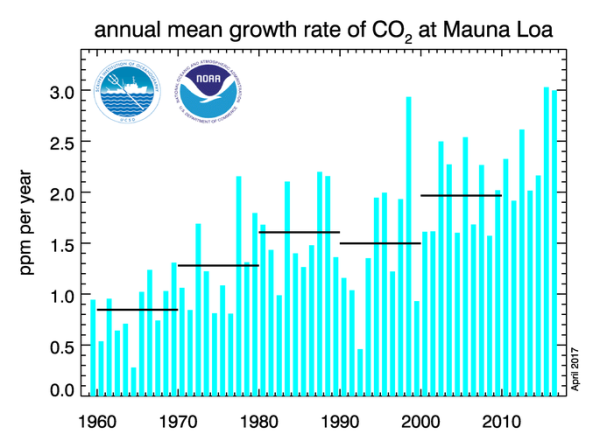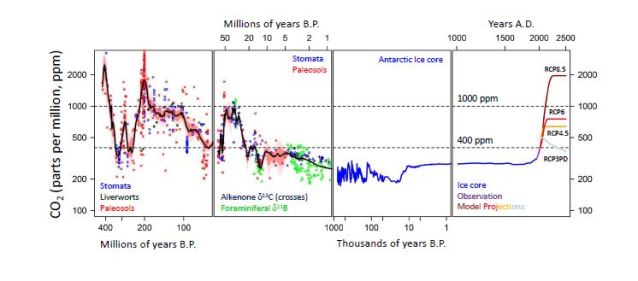Key Heat Trapping Gas Crosses 410 Parts Per Million Threshold — Highest Level in Past 5-20 Million Years
26
April, 2017
This
past week, atmospheric carbon dioxide levels passed a new ominous
milestone.
Clocking
in at 410.7 parts per million at the Mauna Loa Observatory,
this key heat trapping gas hit a range not seen on Earth for many
millions of years.
(The
world crossed the 410 part per million milestone in the daily measure
this week. Image source: The
Keeling Curve.)
These
levels now correspond with the Miocene
Climate Epoch when seas were 120 to 190 feet higher than today and
when global temperatures ranged from 3 to 5 degrees Celsius hotter
than preindustrial averages.
Record
Rates of Accumulation
These
new records come following two years of record rates of atmospheric
CO2 accumulation. According to NOAA, carbon
dioxide accumulated by 3.03 parts per million during 2015 and by 3.00
parts per million during 2016.
These now represent the two fastest rates of carbon dioxide
accumulation in the climate record to date. By comparison, the
substantial warming at the end of the last ice age was accompanied by
an approximate 0.01 part per million per year rate of CO2 increase
averaged over 10,000 years.
2017
rates of atmospheric CO2 accumulation, according to NOAA, appear to
have backed off somewhat in the first quarter. Comparative
gains from Q1 2016 to Q1 2017 are about 2.8 parts per million.
A weak La Nina in the Pacific during late 2016 probably helped ocean
surfaces to cool and to draw down a bit more CO2. However, the rate
of increase is still disturbingly rapid. A 2.8 ppm increase in 2017,
should it emerge, would be the 4th highest annual rate of increase in
the record and would be substantially above past decadal averages.
Hopefully, this still-disturbingly-rapid rate of increase will
continue to tail off a bit through the year. But it is increasingly
clear that the time for urgent action to reduce carbon emissions and
this very harmful related rate of accumulation is now upon us.
(The
CO2 growth rate has recently been ramping higher due to record carbon
emissions during the present decade. Rates of carbon emission will
need to fall away from record high rates in order to tamp down the
presently high rate of accumulation which will tend to trend higher
even if such emissions remain at plateau due to various faltering
carbon sinks and leaking natural carbon stores. Image source: NOAA.)
The
total CO2 increase since major fossil fuel burning began in the 19th
Century is now in the range of 130 parts per million from 280 (ppm)
to today’s high of 410 (ppm). By comparison, during the end of the
last ice age, levels of this heat trapping gas jumped by about 100
(ppm) from around 180 (ppm) to 280 (ppm). Atmospheric averages for
2017 should range about 3-4 ppm lower than the April-May high mark
(which might still hit daily highs of 411 ppm or more). But at
present rates of increase, we’ll be leaving the 410 ppm threshold
level in even the lower average months behind in just a handful of
years.
Depending
on How You Look at it, We’re 5 to 30 Million Years Out of the
Holocene Context
The
primary driver of the present extreme rate of CO2 increase is global
carbon emissions(primarily
from fossil fuel burning) in a record range near 11 billion tons per
year (or nearly 50 billion tons of CO2 equivalent gas each year).
Though 2014 through 2016 saw a plateau in the rate of global carbon
emission, the decadal average accumulation of this emission is still
at record highs. Meanwhile, it appears that warming oceans, lands
more susceptible to deluges and wildfires, increasingly deforested
regions like the Amazon, and thawing Arctic permafrost are less able
to take in this record excess. As a result of these factors, human
fossil fuel emissions will need to fall for a number of years before
we are likely to see an impact on the average annual rate of
atmospheric accumulation of this potent heat-trapping gas.
(Past
paleoclimate proxy records show that we are millions of years out of
the Holocene context when it comes to present levels of atmospheric
CO2 accumulation. Image source:Skeptical
Science.)
Paleoclimate
studies of past epochs are unable to provide 100 percent accuracy for
past atmospheric CO2 levels. However, proxy data provides a good
range of estimates. Based on these measures, it appears that the most
recent likely time when atmospheric CO2 levels were comparable to
those we now see today occurred
around 5 million years ago.
Meanwhile, it appears possible that the last time CO2 levels were so
high extended
as far back as 20 to 25 million years ago.
Unfortunately,
carbon dioxide is not the only heat trapping gas humans have emitted
into the atmosphere. Add in methane and other greenhouse gasses and
you end up with a heat forcing roughly equivalent to 493 parts per
million of CO2 (CO2e) during 2017 at present rates of increase. This
level is very close to the maximum Miocene boundary level of 500
parts per million — a total amount of heat forcing that likely
hasn’t been seen in 20-30 million years.
Serious,
Concerted Action Required to Avoid Worsening Disasters
The
only safe and reliable way to halt the rapid rise of heat trapping
gasses and concurrent warming is to cease emitting carbon to the
atmosphere. Such an undertaking would primarily involve a major shift
away from fossil fuel burning machines and infrastructure.
Present low-cost
renewable energy provides a powerful option for just such a
transition.
In addition, various forms of atmospheric carbon capture from changes
to land use, to biofuel-based carbon capture, to materials-based
carbon capture will be necessary to draw down the extraordinarily
high level of carbon overburden that has already been emitted.
Failing such an undertaking, however ambitious, would consign the
world to increasingly harmful temperature increases and related
damaging geophysical changes for the foreseeable future.
Links:
Hat
tip to Ryan in New England
Hat
tip to Wili
Hat
tip to Erik Frederickson






No comments:
Post a Comment
Note: only a member of this blog may post a comment.